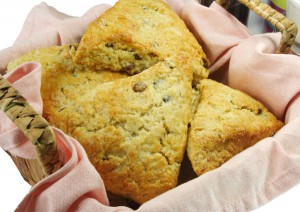By Cynthia Nelson
Hi Everyone,
I know there are folks out there who treat a recipe like an immutable law. They don’t want to mess with the recipe for fear that a Secret Recipe Police will burst into their kitchen and haul them off to the kitchen crimes court. I take a different view. I think a recipe is like a suggestion from a good friend or from someone who has tried out this meal before. It’s your job to play around with that recipe in your quest to get exactly the right taste for you and your family.
Take my experiments with scone recipes, for example. I was disappointed and a little frustrated when I made a batch of raisin scones a couple of months ago from a recipe I thought was a sure winner. First of all, it was too salty and not moist at all. I looked over the recipe to see where I had gone wrong. Did I add more salt than was called for? How could it not be moist when I carefully measured the butter and heavy cream with the requisite number of eggs?
This was the second time I was having this sort of raisin scone experience. On another occasion, the scones (different recipe) again lacked moisture and were bland.

I was determined to get it right so I set about analyzing four recipes from four talented and accomplished celebrity chefs/cookbook authors.
I recognized that the difference had to be in the ingredients because the method of preparation was the same. So I made a spread sheet and broke down the recipes by ingredient by ingredient. Yes, I know that sounds extreme, but what can I say, I am who I am.
The basic list of ingredients was the same: flour, butter, eggs, baking powder, salt, sugar and, of course, raisins. One recipe also called for grated lemon peel and vanilla extract. However, as I carefully studied my spread sheet, I realized that there were variations in the ratio of the butter, liquid and salt to the same amount of flour and eggs.
The quantity of butter ranged from ½ cup to 1 ½ cups. One recipe called for the butter to be at room temperature while the others required chilled butter.
The recipes differed in the liquid to be added; while two called for heavy/whipping cream, the other two indicated buttermilk and milk respectively.
One recipe stood out, requiring two teaspoons of salt while the others only stated ½ teaspoon salt. We all know how I felt about this batch of scones.
Armed with this analytical data and having tested the recipes, I set out to create my own recipe, taking something from each of them. What I realized is that there was nothing wrong with any of these recipes because they were created to suit the taste and palate of the persons who created the recipes. And that is what we always have to remember: recipes are there as guides to be used as something which helps us to make decisions. When we cook, we do it to suit our taste. For example, let’s say I invite you to my home and make a dish that you are familiar with, but, I’ve added ginger to it, to give it my twist, right away you will taste the difference and perhaps not like that version of it at all. It’s the same thing with recipes – that is why there are so many of them out there. You know how many different ways we have of making sweet bread/coconut bread? Or cook-up rice for that matter?
Many of the foods we like, whether it is an ingredient or method of preparation, are as a result of the tastes we grew up with. It’s how our mothers, fathers or grandparents made it and so we acquired that taste. I’m sure you’ve heard comments like: I only eat my grandmother’s cou cou; I prefer the hard dumplings my mother makes; I only eat salt-fish when my father cooks it. The secret to recipes does not lie in specific ingredients or formula but rather with you and your taste and experiences.
Here’s my raisin scones guide. It is very flexible so feel free to adjust, adapt and add your own twists. I promise I won’t send over the Secret Recipe Police. In fact, I’d love to hear your variations and experience baking these scones, so drop me a line when you’ve tried it at: tasteslikehome@gmail.com.









